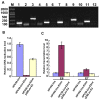Replication and transcription of human papillomavirus type 58 genome in Saccharomyces cerevisiae
- PMID: 21156081
- PMCID: PMC3016283
- DOI: 10.1186/1743-422X-7-368
Replication and transcription of human papillomavirus type 58 genome in Saccharomyces cerevisiae
Abstract
Background: To establish a convenient system for the study of human papillomavirus (HPV), we inserted a Saccharomyces cerevisiae selectable marker, Ura, into HPV58 genome and transformed it into yeast.
Results: HPV58 genome could replicate extrachromosomally in yeast, with transcription of its early and late genes. However, with mutation of the viral E2 gene, HPV58 genome lost its mitotic stability, and the transcription levels of E6 and E7 genes were upregulated.
Conclusions: E2 protein could participate in viral genome maintenance, replication and transcription regulation. This yeast model could be used for the study of certain aspects of HPV life cycle.
Figures



References
-
- Chan PK, Cheung TH, Li WW, Lo KW, Chan MY, Cheung JL, Cheng AF. Association of Human Papillomavirus Type 58 Variant With the Risk of Cervical Cancer. J Natl Cancer Inst. 2002;94:1249–1253. - PubMed
-
- Bielinsky AK, Gerbi SA. Where it all starts: eukaryotic origins of DNA replication. J Cell Sci. 2001;114:643–651. - PubMed
Publication types
MeSH terms
LinkOut - more resources
Full Text Sources

